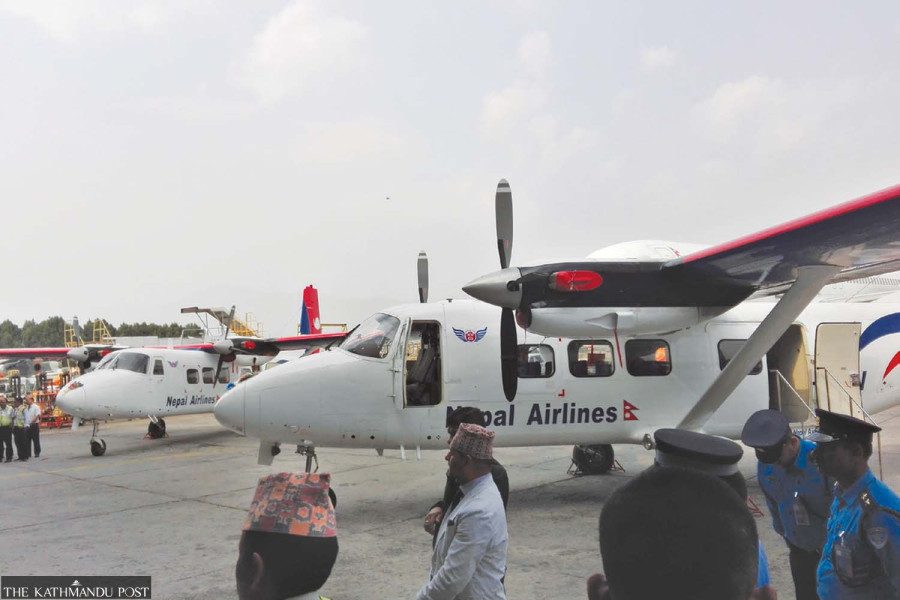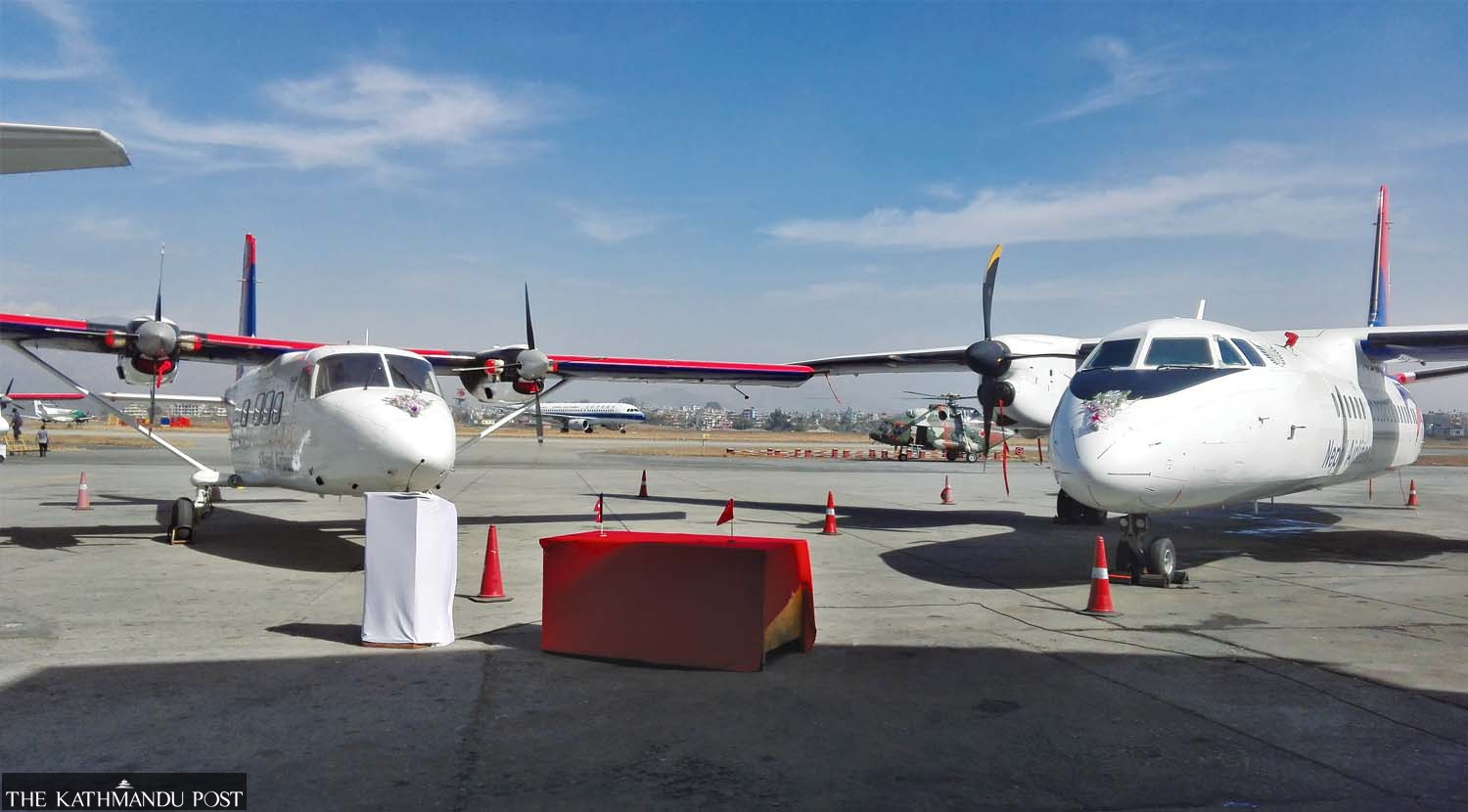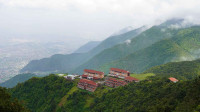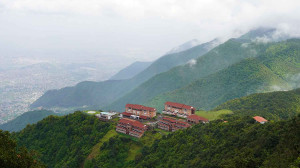Money
Nepal Airlines to sell Chinese planes if nobody wants to lease them
The aircraft spent more time on the ground than in the air, and they were becoming a financial burden on the debt-ridden national flag carrier.
Sangam Prasain
Eight years after acquiring a batch of Chinese planes it had hoped to fly on underserved mountain routes, Nepal Airlines finally decided that it didn't want the albatross around its neck anymore.
Except for operating services to a few airports in the Tarai plains, these aircraft spent more time on the ground than in the air, and they were becoming a financial stress to the debt-ridden national flag carrier.
The Chinese planes have been grounded for more than two years. On September 14, Nepal Airlines issued a notice to lease them out.
The five condemned planes—three 17-seater Y12e aircraft and two 56-seater MA60 aircraft—are parked at the remote parking bay on the eastern side of Tribhuvan International Airport in Kathmandu. Another one crashed in Nepalgunj and is unflyable.
“It’s a dry lease notice,” said Archana Khadka, spokesperson for Nepal Airlines.
Under a dry lease, the owner will provide the aircraft only, without crew or ground staff.
“We followed the Finance Ministry's instructions,” said Khadka. Out of the two options recommended by the Finance Ministry—dry lease or outright sale—Nepal Airlines will try the first one," she said.
“If there are no takers, we will go for the second option.”
The deadline for the bids set by Nepal Airlines is October 31. Some top Nepal Airlines officials say they do not expect to see potential lessees.
Besides maintenance issues and lack of spare parts, Nepal Airlines couldn't find pilots to fly the aircraft, and there was no sense in keeping them anymore.
In November 2012, Nepal Airlines signed a commercial agreement with the Aviation Industry Corporation of China (AVIC), a Chinese government undertaking, to procure six aircraft—two 56-seater MA60s and four 17-seater Y12es.
As part of the deal, China provided grant and concessional loan assistance worth 408 million Chinese yuan (Rs6.67 billion) to purchase the six aircraft.
Out of the total aid money, a grant worth 180 million yuan (Rs2.94 billion) went to pay for one MA60 and one Y12e aircraft; and a loan worth 228 million yuan (Rs3.72 billion) was used to purchase one MA60 and three Y12e aircraft.
The delivery of the rest of the Chinese aircraft was stalled for years after issues appeared in the first batch of planes that arrived in 2014.
These issues included lack of pilots, lack of instructor pilots, lack of spare parts and lack of engineers trained to maintain them.
The second batch of MA60 and Y12e aircraft, as part of the six-aircraft deal between Nepal and China, arrived in January 2017.
The corporation received the final two Y12e aircraft in February 2018.
Nepal Airlines has repeatedly said that the Chinese-made planes were causing heavy losses ever since they were acquired, and that it wants to get rid of them to stop further losses.
The Finance Ministry is the owner of the planes and Nepal Airlines is the operator. The ministry gave the green signal to Nepal Airlines to lease out or sell the planes in March 2021.
In July 2020, the board of directors of Nepal Airlines unanimously decided to stop flying the Chinese planes.
Five months after the decision, in December 2020, the national flag carrier submitted four options to its line ministry—Civil Aviation Ministry—to get rid of the six inefficient Chinese aircraft in its fleet.

The Finance Ministry had offered several options: Ask the aircraft manufacturers to buy back the planes by evaluating their existing worthiness; lease out the planes either on a long- or short-term basis; auction off the planes through a global competitive bidding process, or look for Chinese or international companies or banks interested in buying or leasing them.
“No doubt, the planes can fly. It was a management problem that the shiny new planes never flew for the purpose they were brought,” said Ashok Pokhrel, former board member of Nepal Airlines.
“Now, years after they were acquired, it is wise to sell them rather than keep them in storage,” he said. “If the planes begin to rust, they will become scrap.”
Photos of the aircraft obtained by the Post show that the tail section of the Y12e is covered in moss. There is corrosion appearing on the metal surfaces and components of the aircraft.
“These planes are susceptible to corrosion,” an unnamed senior Nepal Airlines captain told the Post recently.
As corrosion weakens the structural integrity of metal aircraft and its parts, it could lead to expensive repairs and significant safety hazards.
But according to Pokhrel, it will be difficult to find potential lessees. “I doubt companies are interested in flying them.”
As per the notice, the minimum monthly fixed lease rate for the MA60 with registration number 9N-AKQ is $78,097.
In a power-by-the-hour lease rate, the cost to lease the plane is fixed at $700 per flight cycle or $563 per flight hour, whichever is higher.
The fixed cost is typically driven per flight hour, or a calendar period such as monthly, while under the power-by-the-hour lease rate, the maintenance, storage and insurance are all paid by the lessee, saving the lessor's expense if it were to repossess the asset. The lessee now only pays the rent when the aircraft is operated.
Similarly, for the MA60 with registration number 9N-AKR the minimum monthly fixed lease rate is $69,980 and a power-by-the-hour lease rate of either $704 per flight cycle or $564 per flight hour.
According to the notice, the Y12e with call sign 9N-AKS has a minimum monthly fixed lease rate of $29,416, and a power-by-the-hour lease rate of either $80 per flight cycle or $112 per flight hour.
The Y12e with call sign 9N-AKT has a minimum monthly fixed lease rate of $32,886, and a power-by-the-hour lease rate of either $95 per flight cycle or $141 per flight hour.
The Y12e with call sign 9N-AKV has a minimum monthly fixed lease rate of $33,785, and a power-by-the-hour lease rate of either $101 per flight cycle or $151 per flight hour.
All these five turboprops are in storage at Kathmandu airport and are available for inspection on an "as is, where is" basis, according to the notice published by Nepal Airlines on its website.
Only airlines with a valid air operator's certificate and at least one aircraft in their in-house fleet are eligible to bid.
Nepal Airlines, which is known for its atrocious service, planes being grounded most of the time and management changes making news headlines thrice a year, has been ruined by politicking.
Every time a new management team comes, it begins the process to replace the Chinese planes with new Western-made regional turboprops.
“But Nepal Airlines management changes faster than its decisions,” said a top Nepal Airlines official. “There is no stability in the office, and the decisions are unstable as well.”




 16.57°C Kathmandu
16.57°C Kathmandu















